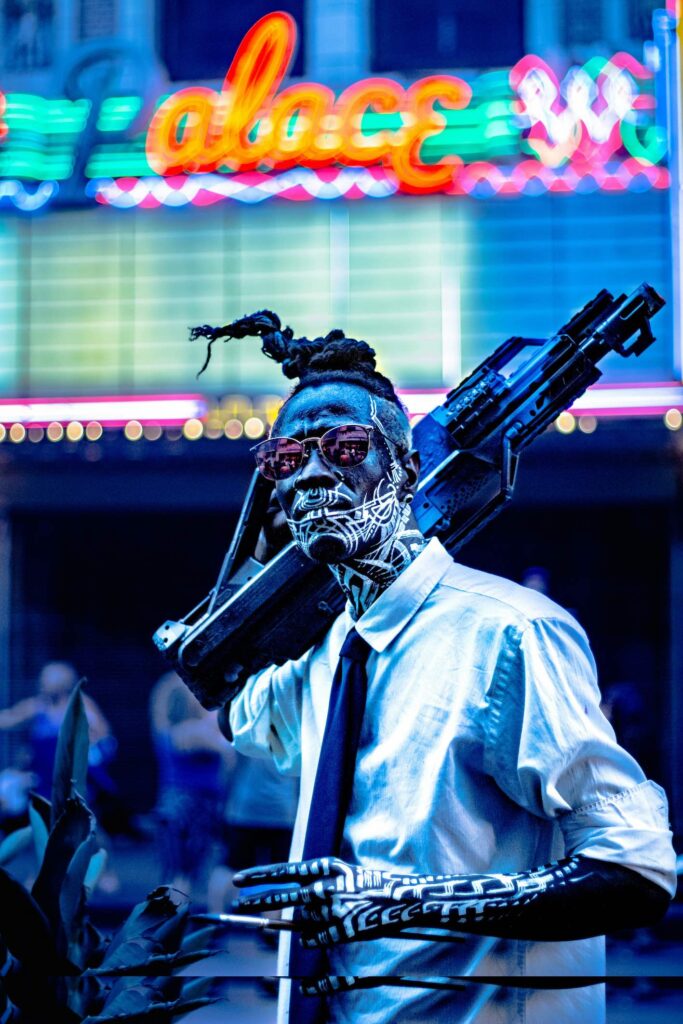Starting in the late 1960s, science fiction authors began to explore futures very different from those imagined by dominant science fiction franchises such as Flash Gordon, Star Wars and Star Trek. One of these new trends was named Cyberpunk and drew from the emergence of new digital paradigms afforded by the computer and early forms of the Internet. Thus, Cyberpunk stories rarely take place in outer space but instead on a planet where these technologies, global warming and hyper-capitalism have transformed not only the climate and geopolitics, but also human and more-than-human relationships. Stories such as Philip K Dick’s Do Androids Dream of Electric Sheep (1968 – the inspiration for the Blade Runner films) or William Gibson’s Neuromancer (1984) thus take place in what has been referred to as cyberspace, and characters can be human-android hybrids or electronic uploads.
Cyberpunk shares certain elements with texts that have been filed as Steampunk by critics and scholars. Like the Cyberpunk story, Steampunk plays out mostly on Earth in worlds directed, and/or eroded by, the capitalist world system as it appeared during the nineteenth century. Unlike Cyberpunk, it thus imagines a future that is exceedingly low-tech, and where coal (the steam engine) is still the dominant source of energy. Steampunk is at once deconstructive of these old energy systems (and of the imperial polities they made possible), and enormously nostalgic, reveling in the aesthetics of British Victorian machinery, architecture and couture. Since the emergence of these genre concepts, critics have employed the notion of -punk to theorize texts such as the Mad Max films as Dieselpunk or biotechnology thrillers such as Mark Budz’s Clade (2004) as Biopunk. Many classic climate fiction novels draw from these different subgenres and are sometimes classified as examples of them.
The point here is that food plays an important role in many of the texts that belong to these subgenres. Cyberpunk is often marked by a turn to non-western modes of eating. Since the genre coincided with the economic rise of Japan, characters in US examples of the genre can be seen to consume ramen noodles and other types of dishes not common in the US at the time. Cyberpunk also explores the possibility of artificial, in-vitro, lab-grown protein. In Gibson’s Neuromancer, a character by the name of Molly is terribly excited by the prospect of eating meat that isn’t “vat stuff” but comes from an animal that has been raised for years and then killed. By contrast, Steampunk tends to imagine people sticking to forms of eating common in nineteenth-century Europe. In this way, visions of food futures are intimately tied to the energy forms and technologies that authors employ to imagine futures.
One of the most recent types of -punk to register on the critical radar is Solarpunk. More than any other genre, this subgenre explores how new and sustainable energy forms (solar power in particular) have paved the way both for continued human life and for a less extractive relationship to the planet. Solarpunk is sometimes referred to as Hopepunk simply because it explores futures where the future is not a constant slog through a polluted, flooded and war-ridden (post)capitalist dystopia. A prime example of this new genre is Becky Chamber’s novella A Psalm for the Wild-Built(2021) and its sequel A Prayer for the Crown Shy. These texts play out in a future where humans have developed technologies and relationships that are not extractive. People still consume meat but the raising of livestock is no longer industrial and erosive to life on the planet. In other Solarpunk stories, many collected in Plant Based Press’s annual Best Vegan Science Fiction and Fantasy collections, diets have been shifted towards the mostly or wholly plant-based form of eating that the EAT-Lancet Commission has described as central to preventing rampant global warming. Solarpunk novels also tend to connect the turn to new vegetarian and vegan diets to other types of profound social change. Thus, the people who have given up meat in futures narrated in Solarpunk fiction have also abandoned the normative class, race and gender relationships that inform much of global society today. The turn away from meat is accompanied by a turn away from toxic forms of masculinity.
When exploring the affordances of science fiction to imagine new and (un)sustainable futures, subgenre conventions matter. The depiction of new and future foods is intimately tied to the conditions that are central to different subgenres of science fiction.
Photo by Judeus Samson on Unsplash

